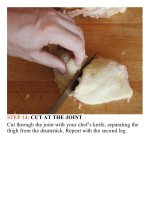The food lab better home cooking through science ( PDFDrive ) 435
Bạn đang xem bản rút gọn của tài liệu. Xem và tải ngay bản đầy đủ của tài liệu tại đây (127.74 KB, 2 trang )
recommend cooking all pork, beef, and lamb to at
least 145°F—well into the medium to medium-well
range. Poultry hasit even worse. The USDA
recommends thatall poultry, whether ground or in
whole parts, be cooked to at least 165°F. It’s no
wonderthatmostfolksthinkchickenisadrymeat.
The USDA likes to play it safe, and their
guidelines for safety are intended to be simple to
understand and foolproof at the expense of being
accurate.The rules are designed such that anybody
from the burger-flipper at Wendy’s to the most
amateurhomecookcanunderstandandgraspthem,
ensuring food safety across the board. I, on the
other hand, prefer to put a little more faith in my
readers’intelligence.
The fact of the matter is that bacteria are not
quite as simple as the “alive at 164°F, dead at
165°F” the guidelines would have you believe them
to be. Rather, a number of factors, including free
moisture, fat content, the levels of dissolved solids
like salt or sugar, and temperature, can all affect
bacterialgrowthanddecayindifferentways.
TheUSDAknowsthis,ofcourse,andifyoudelve
deepenoughintotheirguides,you’llfindsomeuseful
chartsthatbegintoshedsomelightonthesubjectof
meat safety. Below is a graph I put together by
drawing data from their chart on obtaining a 7 log
reduction‡insalmonellainchicken.
MINIMUMSAFE
COOKINGTIME
VERSUS
TEMPERATUREFOR
CHICKEN
What you find is that there isn’t a simple
temperaturelimitthatdefineswhenchickenissafeto









